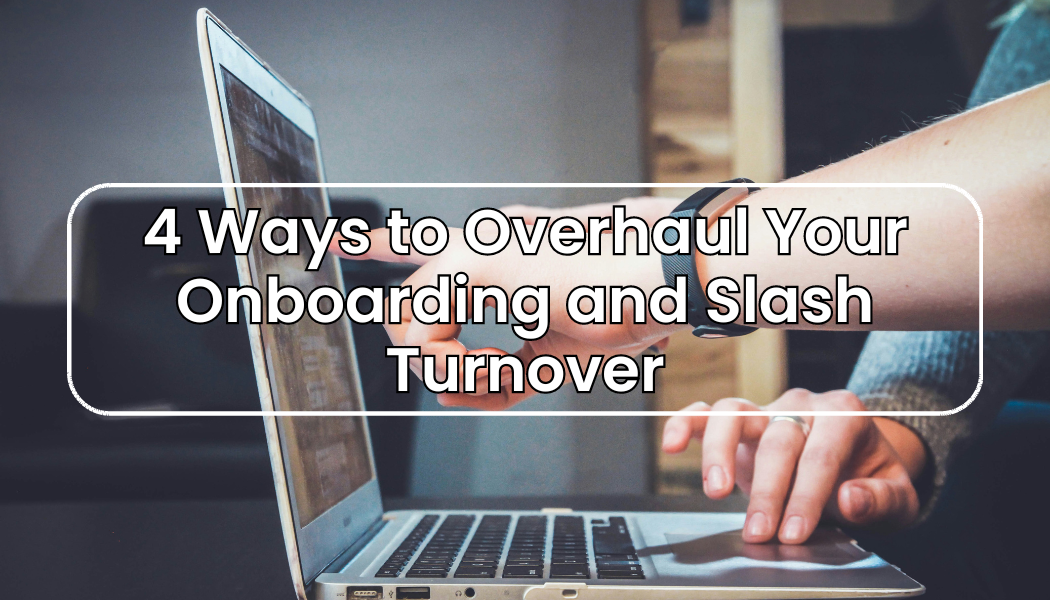We were raised to believe that first impressions are integral to the longevity of a relationship.
Well, somewhere along the line, businesses seem to have forgotten this golden rule. And the end-result is that they’re losing hard-earned profits while they run in a vicious circle, hiring new employees, bringing them onto the team, then watching as they quit. As a manager or business owner, it’s extremely frustrating.
After 35 years of experience managing countless employees across several industries, I’m here to tell you: it’s usually not them that’s the problem… it’s you.
Here are 4 ways for your business to completely overhaul your onboarding procedures and cut down on your staff turnover.
What is Onboarding?
Let’s zoom out for a moment and talk about onboarding: what it is, what you might be doing wrong, and how to fix it.
Onboarding is the process in which new hires are integrated into the organization. This includes activities that allow new employees to complete an initial orientation process as well as learn about the organization and its structure, culture, vision, mission, and values, along with being trained on their job duties. This brings us to the first task to tackle your turnover.
1. Examine and Evaluate Your Current Onboarding Process
You might be saying to yourself, “Well, I already do a great job onboarding my new employees. I always start new hires with welcome baskets and gift cards to the best local shops and restaurants.”
While those are some nice perks, that’s not proper onboarding.
Let me throw some statistics out there.
Losing an employee can cost a company 1.5 to 2 times the employee’s salary. Employees are 69% more likely to stay with a company for three years if they experience a great onboarding procedure, and 78% of organizations that invested in onboarding reported an increase in revenue in the last business year.
With turnover exploding through the deskless workforce and more and more employees planning their exit strategy, taking a hard look at your current approach could end up saving you time and money. Think about how you welcome new hires and introduce them to the rest of the team, how you prepare them to take on their role, and how you plan to keep them engaged in their work as they develop over time.
2. Focus on the Big Topics
When diving into the nitty gritty details of the onboarding process, it can be easy to get overwhelmed. It’s important to focus on the biggest, most immediate ways to deliver effective messaging to your employees.
The Role: Covering the job description and duties is key. Accepting the role is just the start. Once employees become part of the team, it’s important to spend time explaining each responsibility and the correct way for it to be completed.
Priorities: Starting a new job can be very overwhelming, especially in fast-paced environments and when using potentially dangerous equipment and tools, so spelling out initial priorities is integral to onboarding. With so much happening all at once, make sure your new hire knows what is expected of them both in the short term, as well as down the road.
Communication: Simply put, communication is key. Providing new employees with the resources they need to be successful will allow them to take their development into their own hands. Not knowing how to handle something is common, especially in the early stages of a job, so knowing who to ask for help can ease stress and create a more cohesive team.
Company Culture: Consider the values that you have within your organization. What behaviors do you feel properly showcase the culture of your business? What expectations do you have for your staff that they need to be aware of? Remember that your employees reflect your business and represent your brand when they are in public. Taking time to lay these ground rules out ahead of time saves you from having to address poor behavior later.
3. Provide the Tools for Success
A survey from Forbes found that 28% of employees quit within the first 90 to 120 days of employment due to a lack of training and support. By not investing in your new hire, your managers are going to have to repeat the process over and over again. Developing a company standard for training is one of the most important things your organization can strive for.

Picture this: a new hire steps in for their first day of work in a manufacturing facility. They get paired up with another more seasoned employee who is tasked with “showing them the ropes” and getting them up to speed on how to complete their responsibilities.
While this might be a standard procedure in a lot of industries, this is actually a recipe for disaster.
Non-standardized methods of training can be extremely frustrating to a new hire. Pairing new employees with tenured staff might seem like a good idea, but relying on that as your only means to train equates to every new employee getting an inconsistent experience while learning their job skills. It leaves too many variables in play, and can lead to bigger issues like inconsistent messaging, improper and unsafe methods of completing tasks, and can leave huge gaps in knowledge.
Providing an online learning management tool to employees can solve many of these issues. By utilizing curated video training content, everyone learns the same information the correct way, creating company standards and leading with safety and proficiency as a priority.

4. Invest in Continued Development
It’s critical to remember that the onboarding process doesn’t just end; it’s ongoing. It’s a long road that you travel down with every employee that you hire, so implementing a process doesn’t just benefit the employee, it saves time for your managers as well. Because, let’s face it, management is busy enough without constantly providing training and checking in with staff every hour of every day.
In just 6 months, employees will have forgotten 90% of the training you taught them when they began working, so it becomes a struggle for managers to make sure staff members stay engaged, proficient and most importantly, safe at work.
Proper training doesn’t just occur at the start of a job. Ongoing development of skills and content refreshers keep your organization running smoothly, safely, and creates a culture where employees aren’t just working a job, they’re building a career.
Let’s look at Starbucks coffee. In new hire training, Starbucks management utilizes a 70/20/10 approach.

Based on research studying how people integrate and utilize new information, baristas at Starbucks receive approximately 70% of their training through on-the-job experience and hands-on practice. The next 20% comes in the form of feedback and mentorship from their peers, their learning coach, and store management, and the final 10% is derived from an online modularized curriculum.
While it’s good to study other success stories, remember that not every approach will be the right one for your organization.
Final Thoughts
Implementing proper onboarding procedures reduces the time it takes for a new hire to acclimate to the job, encourages and facilitates better working relationships between employees and managers, and allows you to better manage expectations of new employees and allow them to hit the ground running. If you begin nurturing the development of your staff from day one, you’ll have a successful and engaged employee for years to come.
How does your company onboard new employees? What was your best experience being onboarded into a new company? Let us know in the comments.
#gopineapple
